This site contains affiliate links. As an Amazon Associate, I earn a commission from qualifying purchases at no extra cost to you. Full Disclosure Here.
There are plenty of high-priced bushcraft knives out on the market today, but that doesn’t mean you have to empty your wallet to get a dependable bushcraft knife in your hands. The price naturally goes up with knives that feature exotic wood or bone handles, “super steels” with near-magical properties, or any work that has to be done by hand.
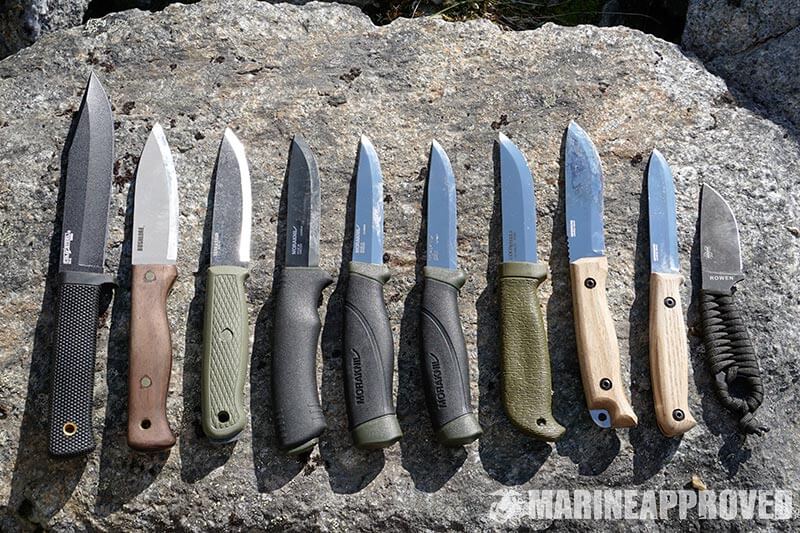
That being said, the knives I personally selected and tested for this budget category have plenty to offer. It would be a mistake to think that you can’t head out into the wilderness with one of the knives on this list simply because the most expensive materials and processes weren’t used. I love a solid high-end knife as much as anyone, but these knives will get the job done and do it well.
I’ve done a full-text review below, but I also made a video overview of all of these knives if you’d like to check it out below:
At A Glance: Our Top 5 Best Budget Bushcraft Knives Under 50 Dollars in 2024
- Best Overall: Morakniv Companion
- Best Heavy Duty Knife: Morakniv Companion HD
- Best Premium: Mora Bushcraft Black
- Best Price: Cold Steel Finn Hawk
- Editor's Choice: Cold Steel SRK
Frequently Asked Questions
Bushcraft is a practice of using basic tools and resources from a forest for survival. Bushcraft also includes other things such as building shelters, managing fires, laying traps, and carving.
Bushcraft knives are medium-sized fixed blade knives that use high-quality steel. They have a good comfortable grip and they are used for carving and doing handwork on wood. They can be carried easily in a sheath.
Consider factors such as steel type, the handle, size, and the sheath. They should be made up of high carbon steel in order to be suitable to be used for wooden handwork.
List of the Best Budget Bushcraft Knives
| IMAGE | PRODUCT | |
|---|---|---|
|
Best Overall
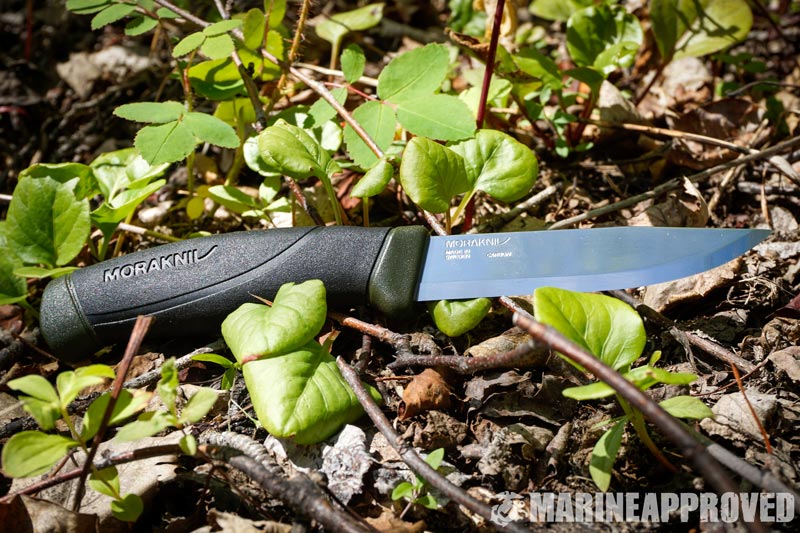 |
Morakniv Companion
|
VIEW ON AMAZON →VIEW ON BLADEHQ → |
|
Best Heavy Duty Knife
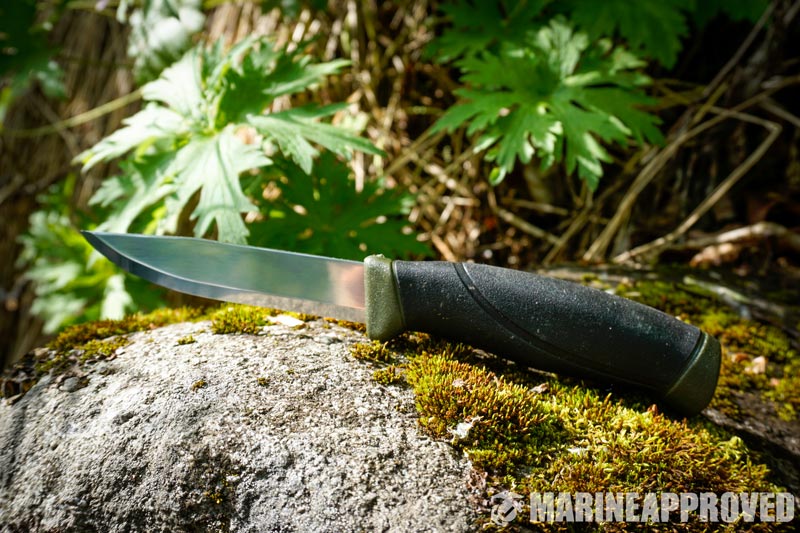 |
Morakniv Companion HD
|
VIEW ON AMAZON →VIEW ON BLADEHQ → |
|
Best Premium
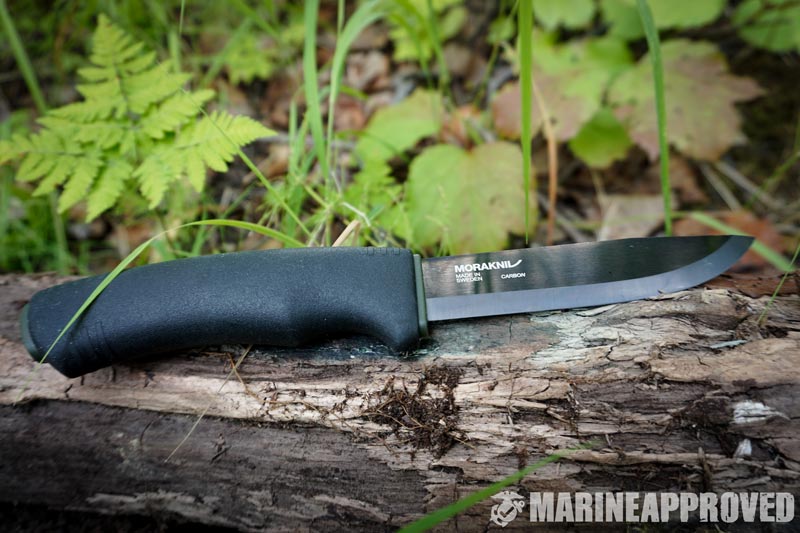 |
Mora Bushcraft Black
|
VIEW ON AMAZON →VIEW ON BLADEHQ → |
|
Best Price
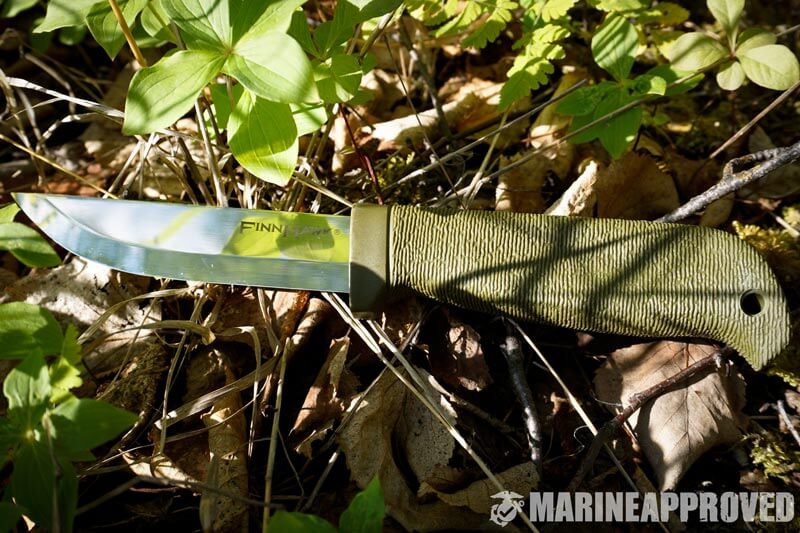 |
Cold Steel Finn Hawk
|
VIEW ON AMAZON →VIEW ON BLADEHQ → |
|
Editor's Choice
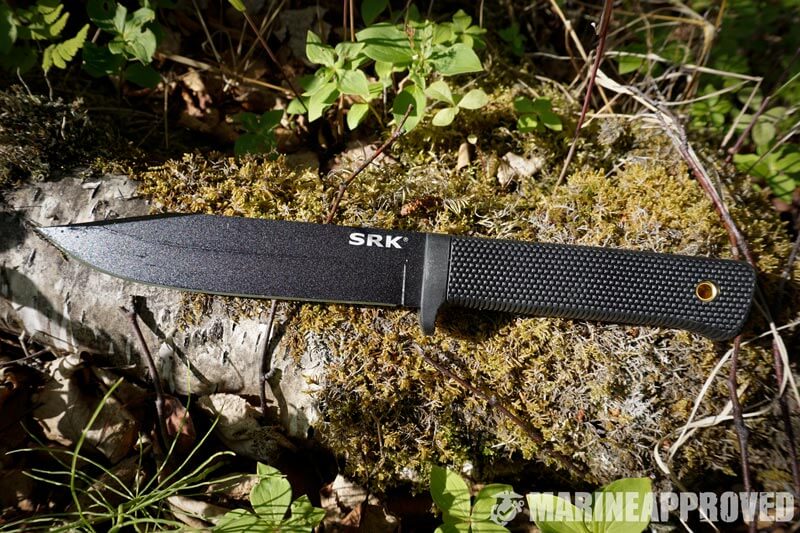 |
Cold Steel SRK
|
VIEW ON AMAZON →VIEW ON BLADEHQ → |
1. Morakniv Companion

Overall length: 8.6 inches
Blade length: 4.1 inches
Blade thickness: 2 mm
Grind: Scandi
Steel: Carbon (58-60 HRC)
Handle material: ABS
Type of Sheath: Plastic
If you’re familiar with any of the knives from Morakniv (often just referred to as “Mora”), it will come at no surprise that three of the ten knives on this list are products of Morakniv. The differences between each of these three knives are subtle, but when it comes to making a quality knife that gets the job done without emptying your wallet, these knives are just hard to beat.
The Mora Companion is light in the hand and easy to maneuver. Much of this is due to the slender blade profile, a common feature in many of the knives by Morakniv. This design makes it easy to get into tight places and do detailed work when carving or drilling holes. Also, of the three Moras on this list, the Companion’s blade thickness is the thinnest at just 2 mm. This allows it to slice through material much easier than knives with a thicker blade stock. In fact, while a scandi grind isn’t usually my favorite grind for cleaning fish, I’ve used the Mora Companion on multiple occasions to clean trout, and it works quite well. The thin blade comes with the compromise of being less rigid and durable, but it’s still plenty strong to handle the majority of bushcraft tasks.
The handle isn’t anything fancy, but it’s comfortable even after extended use, stays grippy when wet, and doesn’t require any maintenance. The size of the handle works well for me (I wear a size large in gloves), but if you have bigger hands, or if you generally prefer a thicker handle, the Mora Companion HD (next on the list) might be a better fit.
When not in use, the knife clicks into a very simple plastic sheath and features a belt clip. The sheath is molded to shape so that it retains the knife, but it leaves some breathing room for the blade. This is helpful when working in wet conditions as it helps to prevent the blade from soaking in trapped water. Also helpful for wet conditions is the drain hole at the bottom of the sheath.
This knife does not have a full tang. In fact, none of the Moras on this list have a full tang. The steel tapers into a rat tail tang (sometimes called a stick tang) that extends about ¾ of the way into the handle. I haven’t had any issues with this design (at least, not from Morakniv), but there are two main disadvantages that come with a partial tang knife compared to one with a full tang. First, a partial tang knife isn’t as sturdy, but that really only comes into play with borderline abusive use. Second, if you end up breaking your handle in the middle of the wilderness, a full tang knife still leaves you with a functional handle and gives you the option of crafting a new handle or wrapping it in 550 cord.
For the price, this knife is really hard to beat. It even contends well against much higher priced knives. There is much to love about some of the high end knives out there, but if you put this Mora Companion to work, you’ll find it quickly becomes the standard by which you judge all your other knives (and at less than 15 bucks, that’s saying something).
2. Morakniv Companion HD

Overall length: 8.7 inches
Blade length: 4.2 inches
Blade thickness: 3.2 mm
Grind: Scandi
Steel: Carbon (58-60 HRC)
Handle material: ABS
Type of Sheath: Plastic
My Review: The Mora Companion HD (Heavy Duty) is exactly what its name implies—it’s a heavier duty version of the Mora Companion. Some of the differences between these two knives are very subtle, but they’re enough to give the Companion HD the advantage when tackling heavier tasks. Since the details and features of the regular Companion have just been discussed, let’s focus on what makes this knife different.
First, and probably most noticeable, is the blade’s thickness. Instead of the 2mm blade featured on the Companion, the Companion HD has a blade thickness of 3.2 mm. This is still plenty thin for slicing, but it’s noticeably more rigid. For example, when making deep cuts into wood in order to remove large amounts of material, the HD’s blade remained stiff while the regular Companion’s blade would sometimes flex a little. The blade of the HD is also longer than the regular version of this knife, but only by a hardly noticeable 1mm.
In comparing these two knives side by side, you’ll also notice that the scandi grind starts higher on the HD than with the regular Companion. This is actually more of a similarity than it is a difference because the higher grind height is compensating for the thicker blade stock. This allows both knives, regardless of their blade thickness, to maintain the proper angle for the grind. So if you’ve used the Mora Companion before, you can expect the HD’s edge to perform just as good. The difference, of course, begins once your cut goes deep enough to reach the blade stock. At that point, the thicker blade of the HD will feel a little more stiff and will lose a little of the regular Companion’s slicing ability.
Moving on to the handle, the HD features not only a longer handle, but a thicker one as well. The palm swell has a lot more belly than the regular HD. This is exactly what is needed for heavier work. For me, the regular companion feels fine in my hand for most tasks, but when I’m doing heavier work, the bigger handle of the HD really starts to make sense.
With a price difference of only about five dollars, choosing between the HD version and the regular Mora Companion comes down to your specific needs and how you use the knife. If you have larger hands, tend to perform a lot of heavy tasks with your knife, or just want a little extra peace of mind that your blade will hold up to what you throw at it, then the HD version of this knife might be a good pick for you.
3. Mora Bushcraft Black

Overall length: 9.15 inches
Blade length: 4.3 inches
Blade thickness: 3.2 mm
Grind: Scandi
Steel: Carbon (59-60 HRC)
Handle material: TPE rubber
Type of Sheath: Polymer sheath
The Mora Bushcraft Black is the final knife on this list from Morakniv. The price (usually around $40) jumps up a little with this knife compared to the two Companion models. It still sits within the budget category, but it’s up to you whether or not the added features are worth the additional price.
The Bushcraft Black shares the same basic blade profile as the Companion models but takes the 3.2 mm thick blade stock of the Companion HD, adds just a little more length (for a total of 4.3 inches), and leaves a 90 degree edge on the spine of the knife. Of the three Moras on this list, this is the only blade with a 90 degree edge on the spine. Personally, I really like this feature on a knife. It’s great for striking a ferrocerium rod, but that isn’t its only use. I’ve used knife spines like this to scrape and gather tinder into a find dust, flesh out plant material for making cordage, clean the scales off fish, and (when I lived in the desert) scrape away the spines and glochids from cactus pads prior to steaming.
Another feature that adds value to this knife is the black DLC (Diamond-Like Coating) treatment on the blade steel. Being a high carbon steel, it’s nice to have some extra protection against the elements, and that’s what the DLC does. There are lots of different types of treatments and coatings that can help to prevent corrosion, but DLC is tough without adding bulk and friction to the blade.
While the blade of the Bushcraft Black shares many of the features with the two Companion models, the handle is where this knife really breaks away. Instead of ABS plastic, TPEs (Thermoplastic Elastomers) are used. The result is a durable handle that has a soft, almost tacky feel to it. In my testing, which included slopping mud, water, and gooey algae over the handle, I found my grip remained very secure. All of the knives on this list did reasonably well with this test, but the Bushcraft Black definitely remained the most secure in my hand when wet.
Part of this amazing grip is due to the handle material, but some of it is due to the handle’s shape. The shape of the Bushcraft Black’s handle differs from that of the Companion models. It shares about the same length as that of the Companion HD, but it features a slightly more pronounced finger guard and slight separation between the index finger and the other three fingers. The handle shape isn’t so extreme that it prevents me from varying my grip or choking up on the blade, but it does help to lock the hand into place when using the knife in the most common grip (forward/hammer grip).
If you’re trying to decide between the three Moras on the list, I’d say that this model is the most complete package for use as a bushcraft knife. The 90 degree edge on the spine, the DLC treatment, and the amazing grip of the handle are all valuable features of the Bushcraft Black. Still, the price jump puts this model at about twice that of the Companion HD and almost three times that of the Companion, so it’s important to weigh out which features are important to you.
4. Cold Steel Finn Hawk

Overall length: 8.5 inches
Blade length: 4 inches
Blade thickness: 2.7 mm
Grind: Scandi
Steel: German 4116 (stainless)
Handle material: Polypropylene encased in ThermoPlastic Rubber.
Type of Sheath: Polymer
The Cold Steel Finn Hawk is another knife that fits well on this list of top 10 budget bushcraft knives. It shares a lot of common features with the Mora lineup (including a low price), but the Finn Hawk is a different animal in a lot of ways.
Cold Steel went with a German stainless steel known as 4116. This isn’t a high end steel (which helps to keep the cost down), but it takes a good edge and holds it reasonably well. With all the talk about “super steels” and other high dollar types of steel, it’s easy to get the impression that anything less is garbage. This simply isn’t true. For most bushcraft needs, a simple steel is not only sufficient, but often preferred.
The blade features a tall scandi grind that allows the edge to not only cut with ease, but to continue slicing even once the material reaches the 2.7 mm blade stock. Some scandi-ground knives are ground at wider angles, causing them to function more like a wedge than a knife edge. The Finn Hawk can definitely slice.
The shape of the Finn Hawk’s blade has a more pronounced belly near the tip when compared to knives like those from Morakniv. This is due to the fact that there is no drop from spine to tip. Instead, the entire spine is flat like traditional Puukko-style knives. This naturally leaves a little more curve near the tip of the blade. This is helpful when skinning and dressing game. I also found it useful in general food prep tasks and when making long, sweeping cuts in wood.
The handle of the knife is built with two different layers of injection molded material. First, a high-impact polypropylene is used to give the handle strength, and second, a thermoplastic rubber is used to give the knife a softer, better grip. This second, outermost layer is covered in textured, wavy lines that further improve the grip. In testing, however, I found that once the knife handle was wet, the feature that really helped me keep my grip on the knife was the slight indention that runs lengthwise through the middle of the handle. My middle and ring finger locked into that indention and kept my grip secure. Another feature on this handle is an indention on the butt of the knife. When held in a reverse grip, the thumb locks into place within that indention.
The knife clicks in with good retention into a polymer sheath. There’s a belt clip molded onto the back just like the Moras, but there isn’t a thumb ledge for drawing the knife. Without this ledge, it’s much more difficult to draw the knife with one hand. Usually, I had to hold the bottom of the sheath with one hand and pull the knife handle with the other. The handle does have a lanyard hole, so a loop of cord could be used to help the draw, but I’m still surprised to see that Cold Steel chose not to add a thumb ledge to this sheath.
5. Cold Steel SRK

Overall length: 10.75 inches
Blade length: 6 inches
Blade thickness: 5mm
Grind: Saber
Steel: SK-5
Handle material: Kray-Ex
Type of Sheath: Secure-Ex (Kydex polymer)
The SRK from Cold Steel is very different from most of the knives on this list. This is actually more of a survival knife than a bushcraft knife, but it made the list anyway. Here’s why:
First, the price of the SK-5 version of this knife gives you a lot of knife for an impressively low cost, so it definitely qualifies for the budget category. As far as bushcraft goes, this knife is bigger and heavier than all the other knives on this list. Still, everyone approaches bushcraft and wilderness living a little differently, and if you’re the type that rarely reaches for the ax or saw, then you might appreciate a larger knife like this.
Six inches of 5mm thick blade is a lot of blade. If you don’t need that kind of reach, I suggest going with a smaller knife. That being said, the SRK is well-balanced and isn’t so heavy that it becomes impossible to maneuver during smaller, more precision work.
The saber grind fits this knife well and allows it to function as a strong and versatile knife. With working with wood, the material doesn’t fall away as easily as it does with a scandi grind, but this knife will take a solid beating for days. The steel is protected from corrosion with the help of Cold Steel’s Tuff-Ex finish, and so far, that finish is holding up well.
The spine of the knife features a 90 degree edge for most of the blade’s length, but changes into a wedge-like shape once it begins its slope toward the tip of the knife. This wedge improves the knife’s ability to perform stabbing tasks, but that’s not something that comes up very often during regular bushcraft duties. Personally, I don’t really like the wedged tip because it makes the knife less effective for batoning wood. It still performs the task quite well, but the wedge tends to eat up the baton with each strike. The knife isn’t quite heavy enough to function well as a chopper, but for light chopping, it does okay.
As I used this knife more and more, I found that while it doesn’t really do any one thing very well, it can do just about anything. That’s where this knife really shines—as an all purpose tool. Again, if you like to do just about everything with your primary bushcraft knife, and you rarely touch the ax, hatchet, or saw, then this knife might work well for you.
The handle of the SRK is made from Cold Steel’s Kray-Ex, which has a firm rubber-like feel to it. The texture that coats the handle is soft enough that it doesn’t tear up your hands, but it’s aggressive enough to be very secure even when wet.
The knife clicks into place within its molded sheath and also features a retention strap that secures around the upper portion of the handle with a snap. There’s plenty of retention within the sheath even without the upper strap, but the extra security is nice and also serves to keep the handle from getting caught on brush and tree branches. The belt loop on the sheath can be pulled apart so you don’t have to undo your belt when you want the sheath on or off. The belt loop is fastened together with hook and loop fabric but includes a single snap as well. I’ve seen similar designs like this that rely solely on the hook and loop fabric, and I was pleased to see the snap on this particular design as it’s much more secure and reliable this way. In my opinion, this is the best budget bushcraft knife under 50 dollars. Although it’s designed as more of a survival knife I really like its versatility.
6. Condor Terrasaur
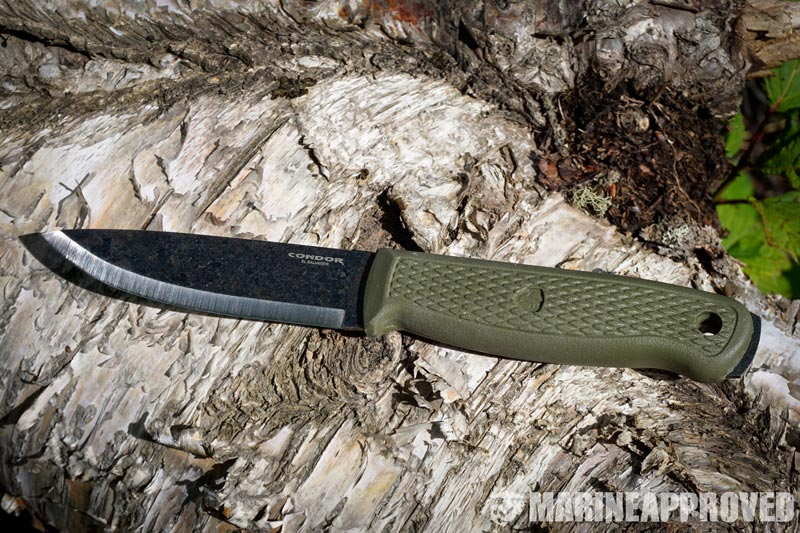
Overall length: 8.8 inches
Blade length: 4.2 inches
Blade thickness: 3 mm
Grind: Scandi
Steel: 1095 high carbon steel
Handle material: High Impact Polypropylene
Type of Sheath: High Impact Polypropylene
The Condor Terrasaur is beautifully simple, in my opinion. In appearance, it might seem a little on the plain side, but in use (which is what these knives are for) the design is everything it needs to be.
Looking at the blade profile, there isn’t much belly on the cutting edge, but that leaves the knife with a good amount of straight edge to work with. This is great for working with wood. The spine of the knife also drops toward the tip at a point just above center line. I’ve used plenty of knives that drop the tip all the way to center line (like a Kephart-style blade), and I really like that design as well, but by keeping the tip just a little higher like this, I find that the knife still performs well with drilling tasks without losing as much of its effectiveness when batoning. This design also lets the user make good use of the blade’s tip during smaller tasks or when getting into hard to reach places. The spine of the knife also includes a 90 degree edge for scraping tasks and for striking ferro rods.
Another feature that adds value to this knife in my opinion is the steel itself. Aside from being full-tang, which I always prefer, this knife is made with 1095 high carbon steel. In this budget category, this is an excellent steel. Like all the steel used for the knives in this list, 1095 won’t hold an edge forever, but it’s soft enough to resist chipping and easy to sharpen (even in the field).
That handle has only slight contours, and a finger guard that almost goes unnoticed. Personally, I really like this about the Terrasaur. It allows me to hold the knife comfortable in a variety of different grips and choke up on the handle without anything getting in my way. The handle’s grip is good, but the high-impact polypropylene doesn’t have much give. In my “wet test” (mud, water, and gooey algae), I found that the textured diamond shapes that run the length of the handle’s sides were essential to keeping my hand in place. That being said, my grip became noticeably less secure once it was wet. I still wouldn’t hesitate to use this knife in wet or bloody conditions, but some extra care is needed to keep the knife in place.
The sheath is molded from high-impact polypropylene and allows the knife to click into place. The sheath is ambidextrous, and features a similar sleek profile to those of Morakniv line and the Finn Hawk. There is a good amount of breathing room around the blade and two draining holes to help minimize corrosion. I found these features helpful not only while I was in the field, but once I came back and needed to dry the sheath out. Some sheaths fit the blade so tightly that it’s nearly impossible to air dry the sheath after returning from the field.
7. Condor Bushlore
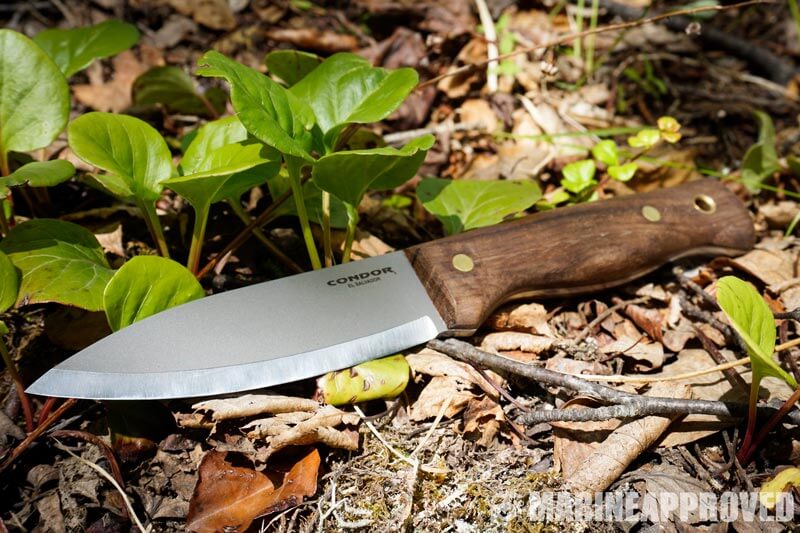
Overall length: 9.3 inches
Blade length: 4.3 inches
Blade thickness: 3 mm
Grind: Scandi
Steel: 1075 High Carbon Steel
Handle material: Walnut
Type of Sheath: Hand Crafted Welted Leather
Condor Knife and Tool’s Bushlore is priced at the higher end of this budget category, but it has a lot to offer, and has easily become many bushcrafter’s go-to knife. This knife also features more traditional materials like a wooden handle and a leather sheath, so if those things are important to you, this knife might be worth looking at.
The blade is made from 1075 high carbon steel, and it’s full tang design is secured to the handle with brass rivets. The blade’s spine drops into a gradual curve and meets the edge right as the center line. Not only does this design make drilling tasks more efficient, but I find that it gives me a high degree of awareness about where the tip is at during precision work or low lighting situations.
The cutting edge of the Bushlore appears to be straight until it nears the tip, but if you look closely, you’ll see that it actually maintains at least some degree of curvature throughout the entire blade. It doesn’t curve so much as to have the pronounced belly of a hunting skinner, but it curves just enough to make long sweeping cuts more smooth and effective.
The handle on this knife is incredibly comfortable. The top portion of the handle is flat, which I personally find more comfortable during extended use than handles that curve downward near the butt of the knife. I’m often opposed to this much contouring in a knife handle because it can sometimes interfere with my ability to grip the knife in anything but a forward grip, but this knife handle works beautifully no matter how I’m holding it.
The handle itself is constructed of walnut, and feels great in the hand. Wooden handles always have a much warmer feel than a lot of other handle materials. The quality and attention to detail with this knife is evident in this handle. At this price range, and being a factory knife, I was surprised at the overall fit and finish. Where the handle meets with the exposed tang of the knife, the transition between materials is smooth. I’ve worked with knives over twice this price that have handles that simply don’t follow the contours of the steel and leave small edges hanging out from the handle. This might not seem like a big deal, but that protruding steel becomes a hot spot after extended use.
As much as I love the handle on this knife, one thing to note about wooden handles is that they do require a little more maintenance if you want them to last. Also, the brass rivets that secure the handle are a nice touch that is usually only seen on higher end knives, but if the handle ever wears badly enough to need replacing, I’d probably just purchase a new knife rather than hassle with cutting the rivets. This is almost a nonissue since the handle is well built and should last a very long time, but the more bullet proof my knife is, the happier I am.
The sheath is leather and features a belt loop on the back. It’s a simple fold-over design, but it’s made with good thick leather that will hold up to rugged use.
8. BPS Knives BS1FTS
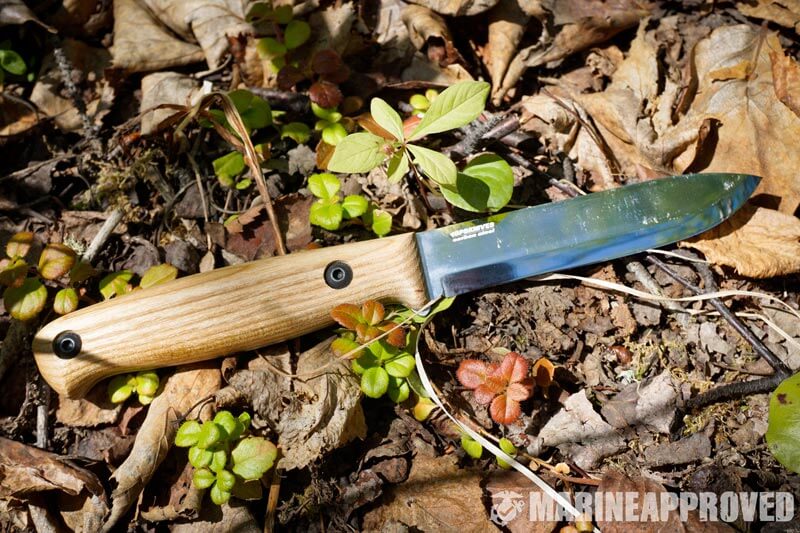
Overall length: 7.87 inches
Blade length: 3.5 inches
Blade thickness: 2 mm
Grind: Scandi
Steel: 1066 Carbon Steel (57-59 HRC)
Handle material: Ash
Type of Sheath: Leather
At 3.55 inches this is dropping below that 4-4.5 inches that I usually like in a bushcraft knife, but this knife has still earned a spot on this list. The knife is clearly designed as a smaller, more compact knife and really excels with the lighter bushcraft tasks. That being said, this knife does have a full-tang blade, and in spite of its 2 mm blade thickness, it handled everything I threw at it. It actually surprised me how well it removed material during wood carving tasks. The thin blade (like the Mora Companion) definitely has its advantages.
The blade height is very narrow (less than 6/8 inch from spine to edge). This makes it very light and nimble. Combined with a drop point that brings the tip near the centerline of the handle, this knife can be used with a high level of precision. The spine of the knife also has a fairly sharp 90 degree edge that adds to the knife’s usefulness.
The handle, which is constructed from ash wood and treated with danish oil, is also very slim. It’s just long enough for my hands (size large in gloves), but there’s little room to spare. That being said, the overall design of this knife is geared toward being compact. In my opinion, the knife would only begin to feel small in the hand if you are using it outside of its intended purpose.
The handle is bolted on, but can be removed with a basic allen wrench. This is a nice feature as it allows the user to customize the handle, remove it for cleaning, or repair it if it gets damaged.
The sheath is a simple leather sheath and appears to be constructed well. The leather is soft and a little more floppy compared to other leather sheaths I’m used to, but for the purposes of this specific knife, it doesn’t concern me much.
Generally, I prefer a little more knife than this for my primary bushcraft knife, but this might be a good fit for some people. If you have small hands, or if you tend to only use your knife for lighter tasks, this knife might be perfect.
9. BPS Knives HK1S
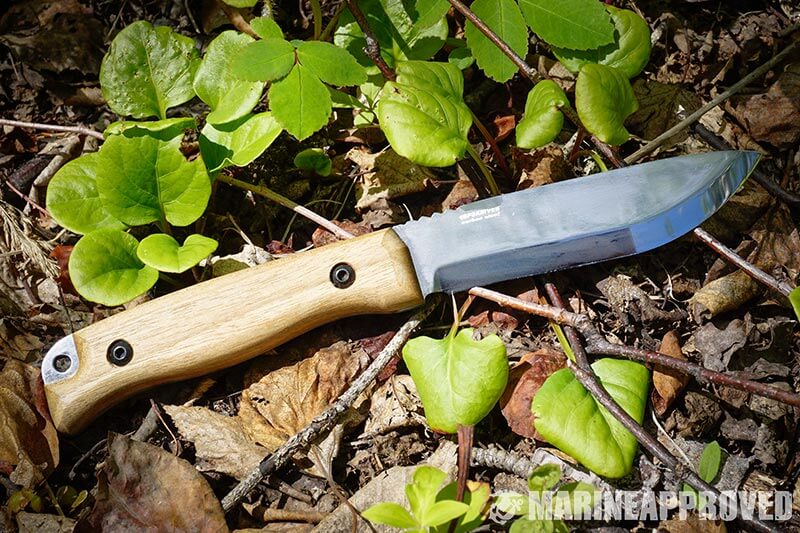
Overall length: 8.66 inches
Blade length: 4.3 inches
Blade thickness: 2.7 mm
Grind: Scandi
Steel: 1066 Carbon Steel (57-59 HRC)
Handle material: Walnut
Type of Sheath: Leather
This is another knife from BPS Knives that just had too much value for the price to not make this list. The HK1S, however, is very different from the BF1FTS already mentioned. The design of this blade is geared toward hunters, but with the scandi grind it performs well at most bushcraft tasks and has the added value of being a capable skinner and field dressing knife.
The belly on the cutting edge is so pronounced that it drops below the line of the blade’s straight edge. The spine of the knife drops, but only slightly. This allows the curvature of the blade’s belly to curve all the way up, leaving plenty of curved edge available for working with game. While I didn’t get to use this knife for field dressing game, I did put it to use in the kitchen and found that it made separating the skin off of raw halibut fillets a breeze. I was able to choke up on the blade and hold it in a pinch grip while slicing away at the skin. There’s also some jimping on the spine, and a sharp 90 degree edge the rest of the length.
The handle material on the HK1s is made from walnut and, like the BS1FTS, is secured with removable bolts. The contouring on this handle is simple, but it provides a comfortable grip. I appreciated the lack of pronounced finger guard on this knife as it allowed me to pinch grip the blade and use the blade’s belly for precision when needed. I found that the length of the handle was adequate for my hands, but if you wear a XL glove or bigger, you might find the handle to be a little short.
The leather sheath for this knife is more heavy duty than the one that comes with the BS1FTS. It also features a standard belt loop as well as a dangler. The knife rides very low in the sheath (only about 1 inch of the knife’s handle protrudes from the leather). This makes the knife a little harder to draw, but it also makes it more secure.
10. ESEE Izula
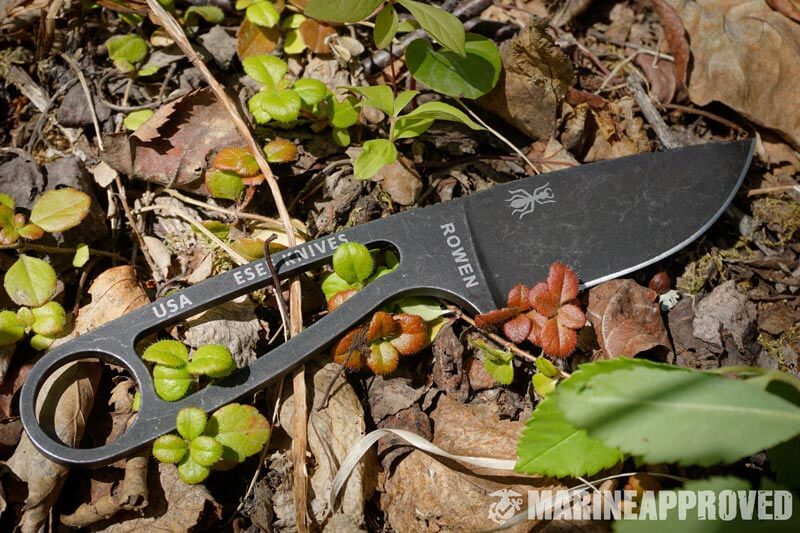
Overall length: 6.25 inches
Blade length: 2.875 inches
Blade thickness: 3.96 mm
Grind: Flat
Steel: 1095 High Carbon Steel
Handle material: No handle
Type of Sheath: Injection molded
The ESEE Izula is great for many things, but as a primary bushcraft knife, this one might not be for everyone. Like the Cold Steel SRK, this knife doesn’t share much in common with the other knives on this list, but for some, it will be just what is needed. This comes down to personal preference, but more than that, it comes down to the environment you’re working in and the specific tasks you use your knife for.
With a blade length of only 2.875 inches, this knife is the smallest on the list. The grind is a flat grind and is treated with a black oxide finish to protect against corrosion. For the same price, ESEE Knives also makes the Izula with a powder coated blade. That type of coating is much more corrosion resistant than a black oxide finish but increases friction from the added bulk. For bushcraft, I prefer the black oxide finish over the powder coating even though it requires a little more maintenance during wet conditions.
This smaller knife size and more minimalist approach is something worth considering if you tend to use an ax, hatchet, or saw for most tasks. Also, when I lived in the desert, I often carried the Izula 2 (which is only slightly larger than this knife) as my primary knife. I found that I simply didn’t need anything bigger for the areas I frequented most. Here in Alaska, however, the situation has changed, and unless I’m carrying some larger tools with me, the Izula is usually too small for my needs. It really just comes down to what you’re working with and how you roll.
{insert smaller version of “Izula with Paracord” beside the following paragraph}
There’s no handle scales fixed to this knife, so using this for heavy cutting tasks is not going to be comfortable. To test this, I carved a tent stake with this knife and intentionally started with a much thicker piece of wood than I needed in order to see how the knife handled the task of removing all that material. It got the job done, but it wasn’t very enjoyable. Wrapping the handle in paracord improved the comfort level a lot, but the ESEE Izula is still designed to be a bare bones knife. With the paracord off, the knife can be used very well in a pinch grip for precision work as there is no handle bulk to get in the way.
The 1095 steel, combined with almost 4 mm of blade thickness at its thickest point, allows this little knife to handle a lot. I batoned deep notches into pieces of wood with this little beast just to see if it would take it, and it handled it just fine. It even proved to be a decent trout knife. After cleaning six rainbow trout with this knife, I found that the flat grind and the amount of belly on the blade’s edge made it nearly perfect for the task. The lack of a handle actually proved to be a benefit while cleaning the fish as I didn’t have to worry about blood and slime soaking into the handle material—everything just washed clean when I was done.
While this might not be the perfect fit for some, it might surprise you what this little blade can accomplish. Also on that note, if you’re familiar with the “no questions asked” lifetime warranty offered by ESEE Knives, you know that you can really put this knife to the test and see what it can take.
As for storage, the knife clicks securely into an injection molded sheath. It also comes with a metal clip that is removable.
Choosing the Right Bushcraft Knife (Buying Guide)
DEFINING BUSHCRAFT
Before getting into the details on these knives, let me clarify how I’m defining “bushcraft” because this term often means different things to different people. For the purposes of this article, bushcraft refers to the skill set required to live in the wilderness on purpose. Wilderness survival, on the other hand, is not something that is done on purpose. There is plenty of obvious overlap between bushcraft and survival, but I’m intentionally separating the two so we can really zero in on this specific category of knives. Perhaps I’ll cover survival knives in a future article, but for now, I’m looking at the category of knife that gets the most use during wilderness living when other tools (ax, saw, machete…etc) are available. This is the bushcraft knife.
A LITTLE ABOUT THIS LIST:
You’ll notice that most of the knives I selected have blade lengths of just over 4 inches. In my experience, that length is long enough for the majority of common bushcraft tasks while still being short enough to handle well and not weigh down your belt. There are a couple of knives on the list that fall outside of this 4 inch sweet spot, and I’ll explain more about those later on.
Another common feature on many of these knives is the type of grind. Most of them have a Scandinavian grind. This is not an essential characteristic of a bushcraft knife, but for me, I find that the majority of the tasks I perform with my knife involve cutting wood, and that’s where the scandi grind really shines.
This article is based on my personal opinion and many hours of work I’ve put these blades through. I ran all these knives through various tasks here in Alaska in order to learn what they had to offer and where they fell short. I paid careful attention to how well these knives yielded themselves for the purposes of bushcraft, but also assessed their overall value. All of these knives were under $50, but I was still aiming to get the best budget bushcraft knife I could for the money.
Frequently Asked Questions
Bushcraft is a practice of using basic tools and resources from a forest for survival. Bushcraft also includes other things such as building shelters, managing fires, laying traps, and carving.
Bushcraft knives are medium-sized fixed blade knives that use high-quality steel. They have a good comfortable grip and they are used for carving and doing handwork on wood. They can be carried easily in a sheath.
Consider factors such as steel type, the handle, size, and the sheath. They should be made up of high carbon steel in order to be suitable to be used for wooden handwork.
FINAL THOUGHTS AND RECOMMENDATIONS:
All of the knives included on this list are excellent tools and come at a low price without compromising what matters most. As a primary bushcraft knife, I personally wouldn’t recommend the Cold Steel SRK or the ESEE Izula unless you feel that your specific needs match the design of those knives. These two knives are excellent knives, but they each represent a different end of the spectrum of what I feel makes a good, general bushcraft knife. So if you pick one of those two knives, make sure you have a reason.
I don’t think you can go wrong with any of the other eight knives. As I mentioned earlier, the BPS BS1FTS is a little on the smaller side (both the handle and the blade), so keep that in mind if you’re thinking about that one. It’s very good for what it’s designed for, but if you’re not carrying a tool for heavier tasks, this might not be the best blade for you.
Aside from that, you might want to consider whether or not you need a full-tang knife. If you do, then stay away from Moras on this list and the Cold Steel Finn Hawk. Then again, at less than $15, you can try out the Morakniv Companion and find out if you really need a full-tang knife after all. That’s not a bad price to pay for a little first-hand knife education.
For me, my top three favorite knives out of this bunch, and the ones that met my bushcraft needs the best, were the Condor Terrasaur, the Condor Bushlore, and the Morakniv Bushcraft Black.
